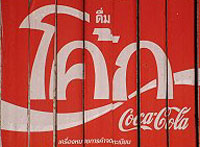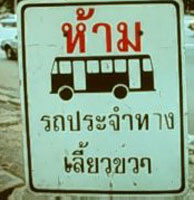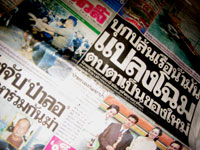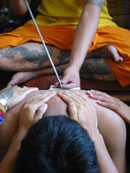Learning to Speak Thai
Maybe you already know that Thai is a language that is spoken using five tones, employs an alphabet of 44 consonants and 32 vowels, is liberally sprinkled with words from Pali and Sanskrit, (the classical languages of Theravada Buddhism and Indian Hinduism, respectively) and looks mighty strange to the western eye.
Many aspects of Thai society focus on rank and relation to one another and this is also reflected in the language. Different nouns and verbs are used when speaking in royal terms, normal fashion, politely and when using slang. The end result? There are seventeen ways of saying ‘I’ and 19 ways of saying ‘you’ in Thai.
Add to this the fact that the letter ‘R’ is rarely pronounced, but rather turned into an ‘L’ or an ‘N’ sound depending on where it is in a word, that the various dialects within the country (Laotian-influenced Thai in the eastern part of the country and the northern Thai dialect, for example), in addition to some vowel sounds needing to be long and others short, and the fact that the letters ‘L’ and ‘R’ are pronounced as ‘N’ when placed at the end of a word and it is no wonder that learners of Thai have moments of immense confusion verging on terror. Thai inevitably becomes translated into phonetic English and road signs illustrate the difficulty of this task. Phetchburi, Petchaburi, Pechburi, and Petcharaburi all refer to the same road.
be long and others short, and the fact that the letters ‘L’ and ‘R’ are pronounced as ‘N’ when placed at the end of a word and it is no wonder that learners of Thai have moments of immense confusion verging on terror. Thai inevitably becomes translated into phonetic English and road signs illustrate the difficulty of this task. Phetchburi, Petchaburi, Pechburi, and Petcharaburi all refer to the same road.
There is not only bad news when it comes to the prospect of learning Thai. The good news is that the grammatical structures of the language are quite easy indeed and tense structures pose no enormous threat as they would if you were to learn English. Building vocabulary in Thai becomes easier and easier the more basic words you know. For example, a hairdresser’s shop is referred to as ‘shop cut hair.’
Something you might not know is that many foreigners living in Thailand can barely speak Thai. Perhaps we should not let the cat out of the bag regarding the fact that a large majority of us can only direct a taxi (Turn left! Turn right! Stop!), argue over prices at the market (50 baht is expensive. How about 30 baht?), order a beer (One Heineken, two glasses please.) and ask for our favourite foods from waiters or food vendors (Fried rice with shrimp, please.) And now confession time. My Thai is still quite horrible and despite another six-week intensive course, hours of meticulous note taking and study, an excellent teacher and even a good report card at the end of class, it is still quite horrendous. Those ‘farangs’ that go around speaking Thai well impress the heck out of the rest of us that just flounder by. But don’t assume that speaking Thai means reading and writing Thai. That is absolutely another can of worms.
that a large majority of us can only direct a taxi (Turn left! Turn right! Stop!), argue over prices at the market (50 baht is expensive. How about 30 baht?), order a beer (One Heineken, two glasses please.) and ask for our favourite foods from waiters or food vendors (Fried rice with shrimp, please.) And now confession time. My Thai is still quite horrible and despite another six-week intensive course, hours of meticulous note taking and study, an excellent teacher and even a good report card at the end of class, it is still quite horrendous. Those ‘farangs’ that go around speaking Thai well impress the heck out of the rest of us that just flounder by. But don’t assume that speaking Thai means reading and writing Thai. That is absolutely another can of worms.
The truth is, you can just fuddle by with bad spoken Thai language skills. If you are in Bangkok or other areas, you usually are faced with someone who speaks better English than you do Thai. If you are out in the countryside and proceed with your rather twisted interpretation of the Thai language and add some arm waving, finger pointing and (perhaps) psychic communication, you usually end up with what you are after. You feel proud after having (falsely) communicated in totally incorrect or even incomprehensible Thai, but somehow it worked and everyone was too polite to correct your disastrous sentence, as is usually the case when host countries face mangled versions of their language around the world.
countryside and proceed with your rather twisted interpretation of the Thai language and add some arm waving, finger pointing and (perhaps) psychic communication, you usually end up with what you are after. You feel proud after having (falsely) communicated in totally incorrect or even incomprehensible Thai, but somehow it worked and everyone was too polite to correct your disastrous sentence, as is usually the case when host countries face mangled versions of their language around the world.
The following sentences are good examples of the Thai language’s ability to terrify potential learners. What could ‘Mai mai mai mai? Mai mai mai mai. Mai mai mai mai.’ possibly mean? With the correct use of tones, these three sentences translate to: ‘Does new wood burn? New wood does not burn. Old wood burns.’ (Of course!)
Most learners of Thai report a steep learning curve in the beginning and smoother sailing from then on. The inevitable tonal mistakes provide ‘sanuk’ (fun) for listeners as they attempt to correctly interpret incorrect and sometimes embarrassing sentences. (The word ‘suay’ when pronounced with rising tone means ‘beautiful.’ When spoken in mid-tone, it means a stronger version of ‘drat!’ or ‘bad luck.’)
But even while listening to their language being spoken in incorrect tones and with horrible mistakes, most Thais will give the brightest of smiles and truly appreciate the fact that you are at least trying. The longer you keep on trying the better your Thai will get (technically speaking), so I guess it’s time for me to dust off my notebooks and textbooks and get to work.
